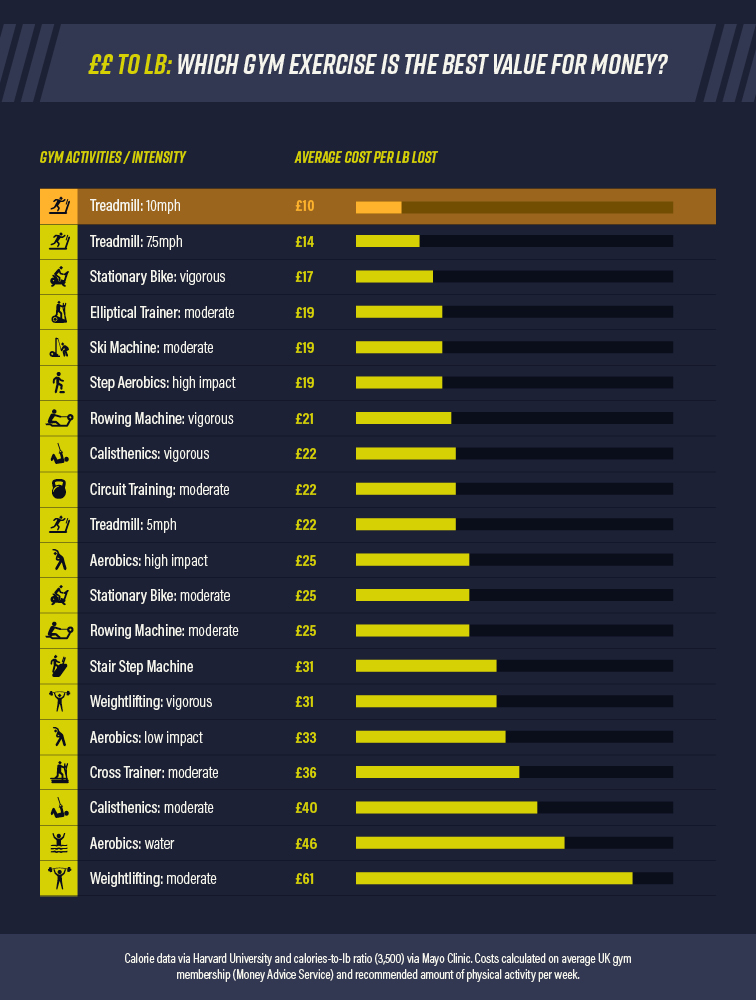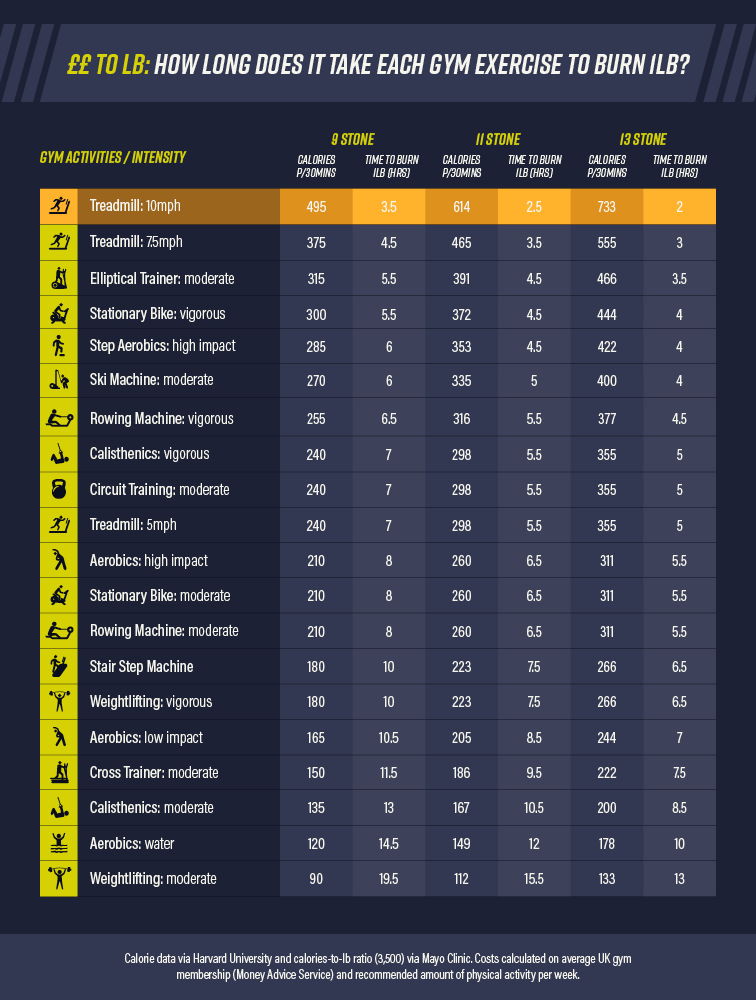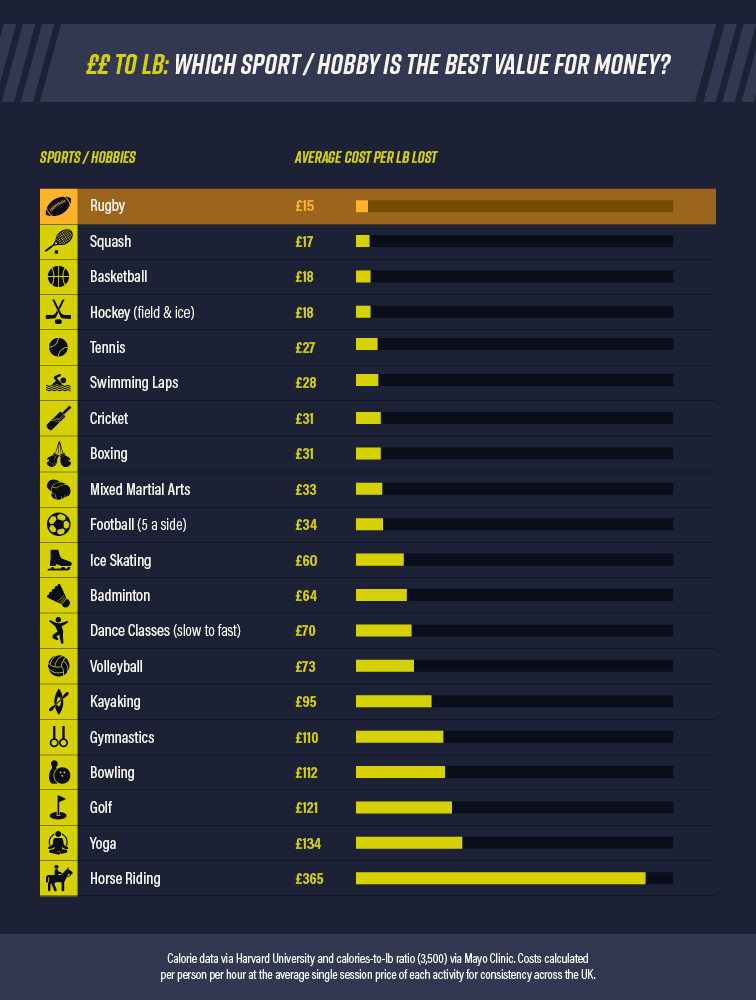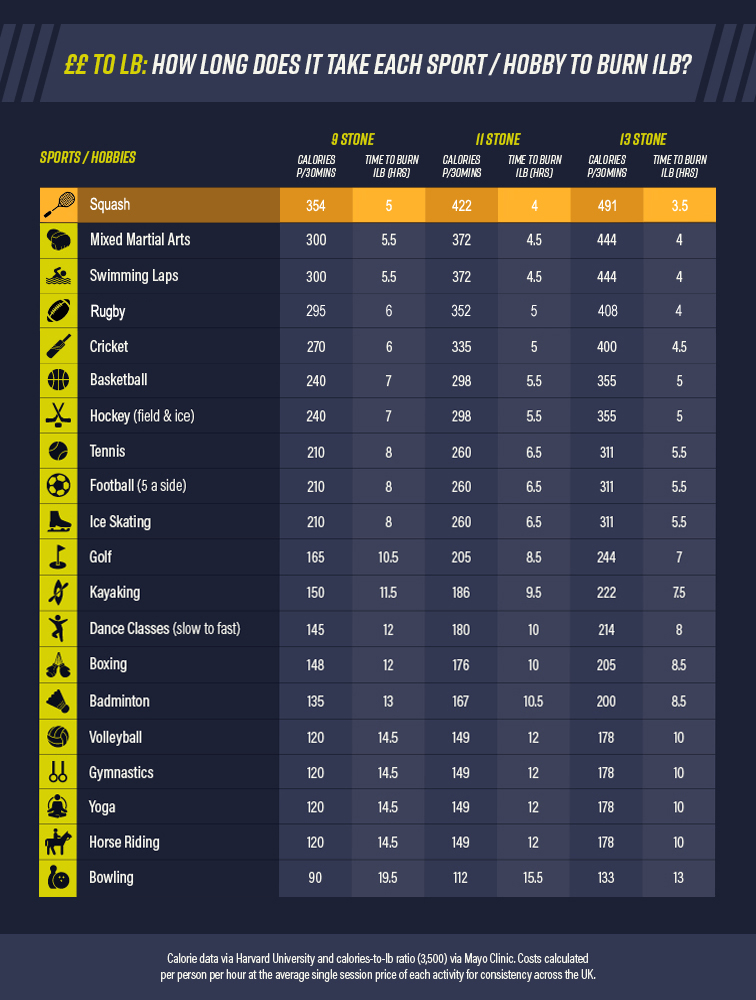Whether you’re exercising to stay in shape, lose a few lockdown pounds or simply because you enjoy keeping active, it’s worth considering how effective your choice of workout is compared to the amount you spend on it.
We’ve put the research in, so you don’t have to, calculating the price per lb lost across a range of gym-based, sports and day-to-day activities.
The Mayo Clinic estimates that it takes an average of 3,500 calories burned to lose a single lb, so we crunched the numbers on how that translates into money spent when you put the hours alongside the cost of gym memberships and sports sessions.
While it’s crucial to observe a healthy diet alongside exercise to see the best results, that doesn’t mean that there aren’t some workouts that are more effective (and better value) than others. When you’re paying for the privilege and have a target in mind, it’s always good to know what will get you to your goal quicker and, ideally, cheaper.
Stick to the treadmill and stationary bike for the fastest, cheapest results
While it’s good to change up which type exercise you do per session to target different areas of the body in the longer term, our research found that straightforward cardio is the most cost-effective way to shift lbs.

People may like to brag about the amount they can lift, but ££ to lb, weightlifting fills two of the most expensive spots in our data. It costs £31 per lb if you choose a vigorous workout or a shocking £61 if you’re taking it a bit easier. If you’re looking to trim down a bit or just to burn off a bit of weekend indulgence quickly and cheaply, it shouldn’t be a priority.
If you’re more inclined to see the world as your gym and prefer to exercise without shelling out for memberships and sessions, our research found that running (£10 per lb on the treadmill) and cycling (£17 per lb on a stationary bike) are the best to stick with, although, for the best effect you’ll have to buy…
- Supportive running shoes (av. £100)
- A high-quality bike (av. £250)
…respectively to get the most out of these activities outdoors. This will save you money in the long run but it’s best to be aware of your upfront costs before committing.
Top Tip: Looking to save money on a gym membership, or just prefer to exercise in your own space? Activities like aerobics and calisthenics can easily be added to your daily routine for free, only requiring your body (and some willpower) to work out around the home.
Here’s how long these gym activities take to burn 1lb (factoring in male and female UK average weights):


Brits have made 22 million visits to the gym since restrictions eased in July
Brits are increasingly flocking to gyms to keep themselves healthy, with 10.4 million people having active memberships as of the start of 2020 – that’s more than 15% of the population!
Not even Covid-19 could deter people looking to get a session in with 22 million visits to gyms in England since reopening in late July after the national lockdown according to ukactive. The fact that they’re providing an impressively safe service by effectively implementing measures to keep members safe (0.34 cases per 100,000 visits) certainly helps.
One of the main benefits of gyms is the number of exercise methods available to you in a single space. You might be able to fit a stationary bike in the spare room but getting a treadmill and rower in there as well might be pushing it.
Rugby is the most cost-effective sport ££ for lb whilst ten-pin bowling beats yoga
Further supporting the importance of intensive cardio on value-for-money calorie burn, it’s the high-impact like rugby (£15 per lb) and squash (£17 per lb) which top the charts whilst more expensive and less rigorous activities like horse riding - costing a staggering £365 per lb - and golf predictably fall short.

Despite the growing popularity of yoga, if you’re attending classes to get some all-important fitness time in on the mat it’s giving you some of the least value per lb of all the activities in our study. Due to its average price per session (£11 per hour) adding up quickly ££ to lb, we found that it’s more cost-effective to go ten-pin bowling to burn calories.
Top Tip: With so many YouTube-led courses available, if you’re looking to watch your outgoings while learning how a vinyasa is different from chaturanga, there’s always a free alternative to a packed studio.
Here’s how long these sports activities take to burn 1lb (factoring in male and female UK average weights):

1/3 of Brits played or participated in some form of sport over the past year
Fitness doesn’t have to be for fitness’ sake. According to a 2020 YouGov survey, almost 1/3 of Brits (33%) had participated in some sort of sport over the past 12 months and that doesn’t even consider the huge range of classes, hobbies, and other activities on offer.
There are also exemptions on some of the tougher restrictions when it comes to organised sports which means they’re a great way to get out and about with others during these uncertain times providing it’s done responsibly (always check local and national guidance).
You can still burn your fair share of calories with activities around the home
It’s no secret that Brits have a bit of a love/hate relationship with exercise. According to a study by not-for-profit health body ukactive we spend, on average, over twice the amount of time each day making cups of tea (40 minutes) than we dedicate to keeping fit (14 minutes).
However, this is based on people not setting time aside for exercise, it doesn’t factor in all the activities you take for granted day-to-day. Here’s how many calories you burn doing things around the house, ticking chores off the list and simply by going through the motions.
Yes, watching TV counts, although it’ll take some serious bingeing to make an impact.

If you’re looking to make chores feel a bit more worthwhile and get some health benefits from them in the process, our research suggests getting out in the garden or, failing that, finally getting around to that redecorating can help burn off last night’s takeaway.
Note: This research focused on exercise in isolation to find the best value physical activity by time spent. It’s important to maintain a balanced diet around this which will help keep the calories at bay more effectively and ensure you stay healthy inside and out.
For more cost-saving tips and articles on how to be a savvy spender, check out the Ocean Finance blog.
Methodology: Calories burned during exercise via Harvard University study and information from ‘Medicine and Science in Sports and Exercise’. Burning 3,500 calories equates to the loss of 1lb according to the Mayo Clinic.
Gym figures based on the average monthly cost of gym membership in the UK which is £40 per month according to the Money Advice Service. According to Planet Fitness (based on medical advice of recommended exercise per week and personal trainer input), if you're looking to stay in shape, three to four 40-minute gym sessions per week is recommended. £40/10.5h = £3.80 per hour.
Sports figures based on average pricing from the largest city in each UK region, using the search '[CITY NAME] [ACTIVITY NAME] session cost' and choosing a provider with the clearest pricing information from Google's Page 1 results. Figures displayed represent individual one-hour session costs per person to ensure consistency across data.














